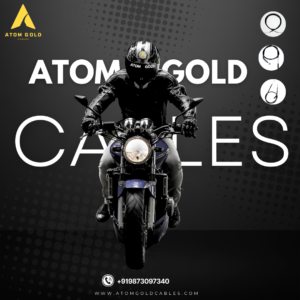In two-wheelers, control cables play a crucial role in various functions, including throttle, clutch, and brakes. These cables are subject to continuous use and face different environmental and mechanical challenges that can impact their life span. Understanding the factors that affect cable life span can help owners maintain their two-wheelers more effectively, avoid frequent repairs, and enhance overall vehicle performance. This article covers the primary factors that influence cable longevity and provides tips on how to extend the life of these essential components.

Importance of Control Cables in Two-Wheelers
Control cables in two-wheelers are responsible for transferring the rider’s inputs to the respective components, enabling the motorcycle to accelerate, stop, or change gears. Given their critical role, any damage or wear to these cables can affect the bike’s responsiveness, handling, and, ultimately, rider safety. Recognizing the factors that affect cable life can help riders take preventative measures and ensure their two-wheeler remains in optimal condition.
1. Material Quality and Construction
The quality of the materials used in control cables significantly affects their durability. Premium-quality cables made from stainless steel or galvanized steel are more resistant to corrosion and wear, which increase their longevity. Additionally, cable housing made from high-quality, weather-resistant materials help protect the inner cable from environmental elements, preventing premature wear.
How to Choose Quality Cables
When replacing control cables, it’s essential to invest in high-quality products. Look for cables with durable outer coatings and corrosion-resistant inner wires. These materials are better equipped to handle the stresses of daily use and are less likely to break or degrade over time.
2. Environmental Conditions
Exposure to harsh environmental conditions is a significant factor in cable degradation. Factors like moisture, salt, dirt, and extreme temperatures can wear down cable materials. For instance:
- Moisture can cause rust and corrosion, especially in areas with high humidity or frequent rain.
- Salt, often present in coastal areas or from road salt in winter, can corrode metal components.
- Dirt and debris can enter the cable housing, creating friction and wearing down the inner cable.
Preventing Environmental Damage
Riders can minimize environmental damage by cleaning their cables regularly and applying lubricants. Using a protective spray can prevent rust, while regular inspections can help identify signs of wear before they worsen.
3. Frequency and Intensity of Use
The life span of two-wheeler control cables is also impacted by how frequently and intensely they are used. Commuters who ride daily or cover long distances put more stress on their cables than occasional riders. The constant tension and pressure can gradually stretch or wear down the cables, leading to reduced performance.
Tips for Heavy Users
If you use your two wheeler daily or for long-distance travel, consider replacing your cables more frequently. Regular maintenance and lubrication are also key to extending the life of high-use cables.
4. Cable Tension and Adjustment
Proper cable tension is essential for ensuring smooth operation and longevity. Overlay tight cables can increase friction, leading to accelerated wear, while loose cables may not function correctly, creating handling issues. Both under-tensioned and over-tensioned cables can decrease the life span of control cables by placing unnecessary strain on the internal wires and housing.
Regular Adjustment and Maintenance
Check the tension of your cables regularly and adjust them according to the manufacturer’s specifications. Regular adjustments not only improve handling but also help prevent premature cable wear, especially for brake and clutch cables.
5. Friction and Lack of Lubrication
Friction is a constant challenge for control cables, particularly for components that move frequently, like the throttle and clutch cables. Without adequate lubrication, friction increases, causing wear on the cable’s surface. This can lead to cable fraying or breakage over time.
The Importance of Lubrication
Applying a lubricant designed specifically for control cables reduces friction, allowing the inner cable to move smoothly within its housing. It’s recommended to lubricate cables periodically, especially after riding in wet or dusty conditions, to ensure optimal performance and longevity.
6. Poor Installation or Maintenance Practices
Incorrect installation or poor maintenance practices can significantly shorten the life span of control cables. For instance, cables that are installed with sharp bends or without enough slack may break prematurely. Additionally, neglecting routine maintenance like cleaning and lubricating cables can result in poor performance and early wear.
Ensuring Proper Installation and Maintenance
When installing cables, follow the manufacturer’s guidelines and avoid sharp bends. If you’re unsure about installation, seek professional assistance. Performing regular maintenance checks can help you spot any issues before they lead to failure.
7. Mechanical Wear and Tear
Over time, the normal wear and tear from frequent use will take its toll on control cables. As cables are used, they experience micro-movements within their housing that gradually wear down both the cable and the housing material. This wear can lead to stretching, fraying, or internal damage.
Recognizing Signs of Wear
Riders should inspect their cables periodically for signs of wear, such as visible fraying, stiffness, or delayed response. Catching these early signs can help you replace cables before they cause more serious issues or affect the safety of the vehicle.
8. Heat and Vibration
Motorcycles generate significant amounts of heat and vibration, especially when used for long rides or on rough roads. This constant exposure can weaken control cables, particularly if the cables are close to the engine or exhaust system. Excessive heat can cause cable coatings to deteriorate, while vibration can lead to cable loosening or fraying over time.
Protecting Cables from Heat and Vibration
Riders can use heat-resistant covers for cables that run near the engine or exhaust system. Regularly checking and tightening cable connections can also help reduce the impact of vibration on cable integrity.
9. Quality of Cable Housing
Cable housing plays an important role in protecting the inner cable from environmental exposure, friction, and mechanical strain. High-quality housings made from durable, weather-resistant materials help prevent wear and increase cable life. Conversely, low-quality housing can degrade quickly, exposing the cable to damage.
Choosing Durable Cable Housing
Opt for control cables with reinforced or double-layered housing, especially if you frequently ride in harsh environments. Quality housing can extend cable life by providing better protection against external factors.
Conclusion
The life span of control cables in two-wheelers is influenced by several factors, including material quality, environmental conditions, frequency of use, and proper maintenance. By understanding these factors and taking preventative measures, riders can prolong the life of their cables and maintain the performance and safety of their motorcycles. Regular inspections, adjustments, and lubrication are essential practices that can keep control cables in optimal condition and reduce the likelihood of unexpected failures.
Find the Atom Gold difference today – where the heritage of the past is merged with the technology of the future, and quality is the standard.
For more information about our products or to place an order, visit our website or contact us at our office in Ghaziabad, UP. Let us help you drive with confidence, powered by the best accelerator cables in the industry.
Visit us at -Shree Radha Nath Automotive Pvt Ltd , Plot No-35, NCR Industrial Park GT Road Sahibabad, Near Raj Bagh Metro Station, Ghaziabad, UP -201005. Mobile- 9873097340, 82870 63431 Ghaziabad, Uttar Pradesh, India 201005
